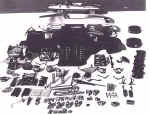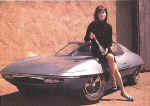Piranha Chassis(The XPIT Chassis was also known as the Piranha.) D Modified |
The early cars were known as Marbons See this external link to a great page on the Piranha "Roots". |
IntroductionEngine: Corvair Builder: William M. Schmidt Associates and the Jentzen-Miller Co., after the initial prototype by Marbon Chemical.1 "The first vehicle, called the CRV, consisted of a two-piece thermoformed plastic body mounted on a tubular chassis. |
|
CRV II"The next prototype was called the CRV-II and was equipped with a Corvair engine and featured a monocoque chassis constructed of Cycolac with metal braces for suspension pieces. It weighed only 1,400 pounds. The upper body received some changes and included a roll bar. 'The CRV-II was raced in the 1965 SCCA National Road Races and won the Central Division Championship in D Modified, was first in class in half of its races, and placed in the
rest. The CRV-II never failed to finish a race it entered.' Note the bulges in rear body panels to allow for the larger racing tires."1 |
|
| "To help promote interest in the car, AMT also offered a kit of a roadster version of the Piranha for SCCA racing. Below is a photo of
all the parts included in the kit. Note the completed race car in the background.
Unfortunately, interest in the limited production car was not what AMT had hoped for. That, coupled with the cancellation of the Corvair by Chevrolet and a recession in the model car hobby, forced AMT to close the project."1 |
|
UncleThe "produciton" version of the car later stared in select episodes of the "Man from U.N.C.L.E." and "Girl from U.N.C.L.E." television shows from the mid-60's. The car used for the shows was a customized version of the car sold to the public. |






